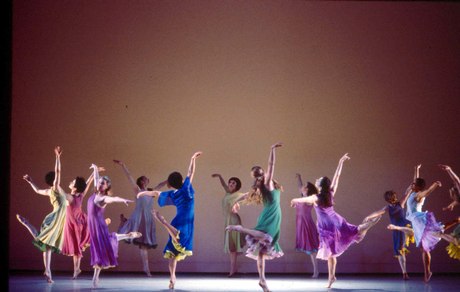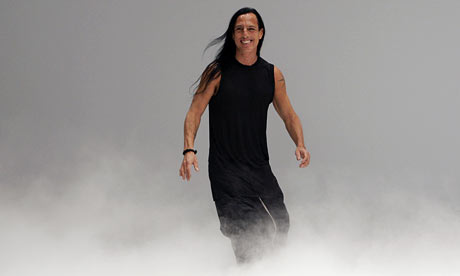“Dancing is one of the purest and simplest expressions of
joy, and I feel a moral responsibility to enjoy it.” –Rick Owens, designer (interview in Harper's Bazaar, October, 2013)
Okay, so perhaps Monsieur Owens is talking about his
clubbing lifestyle in Paris, but still, I have to say, he gets it right. The
joy is why I dance. What other motivation could I have, at my age, with my
particular physical and artistic limitations? I like the idea though that it is
one’s moral responsibility to seek pleasure, to enjoy this thing. Is that really
a moral position?
On second thought, perhaps he means that the moral component
to it comes in at the level of the purity and simplicity. Certainly, those are
values quite often associated with morality in more than one of the world’s
religious and/or philosophical traditions; Buddhism, say, or Stoicism, or
Cistercian monasticism, and the list goes on. What is it about pure and simple
that seems so Good? Is it that in an environment of the pure (Unadulterated? Unclouded?)
and simple (Straightforward? Absence of complexity?) it is difficult to hide
the little evasions and doublings-back that constitute the fertile soil of
dishonesty, deception, and fraud?
Can you tell that I’ve been spending my time with a
moralizing treatise (my academic research, of late)?
Simplicity and ballet have a, well, complicated history. On
the one hand, to be “classical” is, as I always discuss with my novice art
history students, to subscribe to an irreducible aesthetic, an unadorned, “pure”
realization of an ideal. No furbelows or curlicues allowed, no excesses of
ornament, expression, or eccentricity admitted. The Parthenon, not the Temple
of Artemis at Ephesus.
With ballet, I suppose, this means the essentials of form:
turnout, pointed feet, the extended leg, the stable pelvis, the fluid
port-de-bras, the deep flexion of the plié, the weightless, yet carefully held balon. Balanchine, the great “neo-Classical”
choreographer, got this; to be classical, one must constantly return to a strict
interpretation of the canon, even if at moments one departs from it. In Serenade, the corps stands in its ranks on stage at the
opening of the piec,e right arms raised almost in a gesture of ad locutio, everything perfectly
classical, from their high chignons to their long, white tutus, except for this:
they are turned in, parallel, standing flat. But suddenly, on the downbeat of
measure ten, having executed a gnomic port de bras, they all turn out to first
position, and it has always seemed to me that that moment, really, is when the
ballet begins. It says, “now we’re dancing, now we are classical, and
everything before this was just prefatory.”
 |
| L'Allegro: Folksy fun... seriously. |
If the rule of classicism is simplicity, lots of ballet just
fails to make the cut, and this is not necessarily a bad thing. Mark Morris,
for example, does not choreograph “classical” ballet, and I don’t think he set
out to do so. Instead, there is something vibrant and robust about his
anti-classicism (whether we’re talking The
Hard Nut or L’Allegro), something
loose and fresh and Dionysian about it that makes one wonder what the big deal
is about the Parthenon anyway. Who wants Athena when one can have a bacchanal?
I actually prefer his brand of anti-classicism to Twyla Tharp’s or Alvin Ailey’s,
which always seem more mannered and anxious to me; I think of them as being
good students who have something to prove about their individuality and their
ability to think outside the box, while Mark Morris is like that kid in the
wrong sneakers and the bad haircut who just doesn’t give a damn and yet manages
to be the Big Man on Campus anyhow. He's that guy dancing at the Phish concert who is all sweaty and spazzy and yet magnetic -- everyone wants to dance near him because the joy is just sloshing all over the place like silly string. And of course this is all an illusion, since in fact Morris' company is ultra-disciplined and nothing about what they do is haphazard.
 |
| No question: that's classic Martha Graham. |
This really comes through if you compare how Morris treats
folk themes to how “folk” was transformed by Martha Graham, who was so damn earnest
about classicism and simplicity it almost makes me dizzy. I’m thinking, in particular,
of the high-Modernist dudgeon of Appalachian
Spring (maybe parts of it were meant to elicit chuckles, maybe not, I
cannot decide). There’s a great film of this, available on You Tube thanks to
DanceOnFilm (http://www.youtube.com/user/danceonfilm?feature=watch),
and you can decide for yourself if it’s just dated, or if that Preacher and his
Worshipers aren’t meant to be just a little bit satirical?
Still, at its heart Appalachian
Spring is classical in the way that Modernism is classical; serious, lucid,
and formal. The original sets were by Isamu Noguchi, for heaven’s sake! It
doesn’t get more classical than that. Even Graham’s vocabulary of movement,
while not ballet, is founded on the same kind of control, regulation, and
economy of gesture that is the basis of ballet. I particularly notice this in
the pas-de-deux sections between the Bride and the Groom, which after all are
just another version of the classical ballet pairing of cavalier and ballerina,
with the same old theme of love and its endless potential to deliver both
delight and pain.
In any case, if one ever had any doubts as to the
classicism-rooted-in-simplicity values implicit in Graham’s modernism, one has
only to examine the theme of the score she commissioned from Aaron Copland. The
whole thing revolves around the Shaker hymn, “Simple Gifts,” by Joseph Brackett
(contrary to popular opinion, the tune is not just some anonymous folk tune –
some musicologists even think that Brackett borrowed the theme from the English
Renaissance composer William Byrd).
Regardless of the origins of the song, or
Copland’s awareness of them, “Simple Gifts” is itself a song both about dancing
and for dancing to. According to Belden Lane, in Landscapes of the Sacred: Geography
and Narrative in American Spirituality (1988), Shaker communities conceived
of dance not just as an expression of spiritual fervor, but as a staking-claim
to the territory of this world for the Lord, an essential labor through which
the terrestrial and the heavenly spheres were aligned and brought together.
The lyrics clearly articulate this idea of the relationship
between ritualized movement, joy, and sacred space; “to bow and bend… to turn
will be our delight, till by turning, turning we come ‘round right.”
 |
| Eighteenth-century Shakers boogie down |
'Tis the gift to be simple, 'tis the gift to
be free
'Tis the gift to come down where we ought to
be,
And when we find ourselves in the place just
right,
'Twill be in the valley of love and delight.
When true simplicity is gain'd,
To bow and to bend we shan't be asham'd,
To turn, turn will be our delight,
Till by turning, turning we come 'round right
The Sufis had the same idea: “We come spinning out of
darkness, scattering stars like dust,” says Rumi.
 |
| Medieval line dance? |
And so did the medieval
Christian mystics, or whoever it was who first conjured up the idea of Jesus as
the “Lord of the Dance,” made popular by the English lyric, “Tomorrow Shall Be
My Dancing Day,” that many composers (in my mind, most notably Gustav Holst)
have set to music. All that seems to be certain is it predates the Reformation,
and that in late medieval England, parishes organized dancing processions to
raise money in order to keep the church buildings and properties from going to
pieces. So dancing was literally spinning a web of security around the sacred
places of the parish (see Audrey Douglas, “Owre Thanssynge Day: Parish Dance in
Salisbury,” Folk Music Journal, 6
(1994): 600-616).
So maybe Rick Owens is onto something really profound,
something that all those Baptist ministers caricaturized in such films as Footloose completely misunderstand.
Dancing is fundamentally moral, because it is joyful, because it is simple,
because it is pure.
An afterthought…
I’m not sure where Miley Cyrus and twerking fit into all
this, but perhaps she is just, in her way, helping to delineate the sacred
landscape of contemporary pop culture. To bow and to bend she is certainly not ashamed!


No comments:
Post a Comment